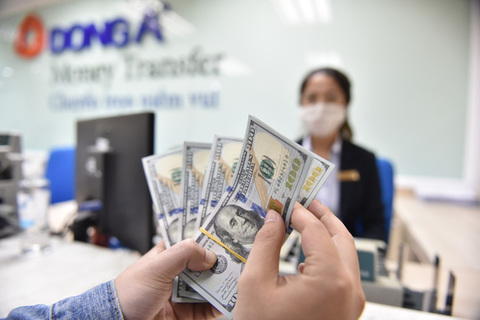Vietnam remained the ninth largest remittance recipient globally with an inflow of US$17.2 billion in 2020, around the same amount received in 2019 and accounting for 5% of its GDP, according to the World Bank’s latest data.
This was a fourth consecutive year that Vietnam remains in the top 10 in terms of remittance, with the figure being US$13.8 billion in 2017 and US$15.9 billion in 2018. As a result, Vietnam received a total of around US$71 billion in remittances in the past five years, or an average growth of 6% per year.
 |
| Top 10 remittance recipients. Source: WB |
India claimed the top spot in the top 10 with an estimated of US$83 billion, followed by China with US$60 billion and Mexico with US$43 billion.
In the East Asian and Pacific region, in 2020, Vietnam ranked third after China and the Philippines (US$34.9 billion) – the world’s fourth largest recipient.
Nguyen Hoang Minh, deputy head of the State Bank of Vietnam in Ho Chi Minh City expects remittances to Vietnam would continue to rise, referring to his estimate that remittances to the city reaching a record of US$6.5 billion this year, marking an increase of 15% from its previous record of $6.1 billion in 2020.
Minh said the rising volume of remittances, especially during the Covid-19 pandemic, would help Vietnam keep its currency stable, while increases in foreign direct investment and exports would ensure sufficient supply of foreign currency, in turn facilitating government’s policies supporting businesses to cope with negative impacts caused by the pandemic.
The Vietnamese dong (VND) was among the most stable currencies in Asia, with the USD/VND exchange rate fluctuating around VND23,200-23,250 per US dollar in the first quarter of 2021, around the same of last year. In this regard, other currencies have sharply depreciated against the USD, including JPY (-7.26%), EUR (-4.12%), THB (-4.5%), KRW (-4.19%), and CNY (-0.57%).
 |
| Vietnam received a total of around US$71 billion in remittances in the past five years, or an average growth of 6% per year. File photo |
Critical lifeline for the poor
According to the World Bank, remittance flows remained resilient in 2020 despite Covid-19, registering a smaller decline than previously projected.
Officially recorded remittance flows to low- and middle-income countries reached US$540 billion in 2020, just 1.6% below the 2019 total of US$548 billion.
“The decline in recorded remittance flows in 2020 was smaller than the one during the 2009 global financial crisis (4.8%). It was also far lower than the fall in foreign direct investment (FDI) flows to low- and middle-income countries,” noted the bank.
The main drivers for the steady flow included fiscal stimulus that resulted in better-than-expected economic conditions in host countries, a shift in flows from cash to digital and from informal to formal channels, and cyclical movements in oil prices and currency exchange rates.
The true size of remittances, which includes formal and informal flows, is believed to be larger than officially reported data, though the extent of the impact of Covid-19 on informal flows is unclear, it added.
“As Covid-19 still devastates families around the world, remittances continue to provide a critical lifeline for the poor and vulnerable,” said Michal Rutkowski, Global Director of the Social Protection and Jobs Global Practice at the World Bank. “Supportive policy responses, together with national social protection systems, should continue to be inclusive of all communities, including migrants.”
With global growth expected to rebound further in 2021 and 2022, remittance flows to low- and middle-income countries are expected to increase by 2.6% to US$553 billion in 2021 and by 2.2% to US$565 billion in 2022, stated the World Bank.
Hanoitimes

Remittances to HCM City hit all-time high in 2020: US$6.1 billion
Remittances transferred to HCM Cịty last year reached a record US$6.1 billion, an increase of 12 per cent year on year.